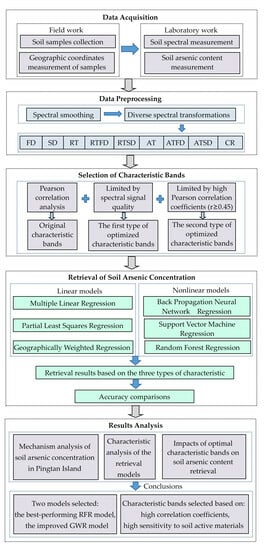Ground-Based Hyperspectral Retrieval of Soil Arsenic Concentration in Pingtan Island, China
Abstract
:1. Introduction
2. Materials and Methods
2.1. Study Area and Experimental Data
2.2. Retrieval Methods of Soil Arsenic Concentration
- A
- Multiple Linear Regression Model (MLR)
- B
- Partial Least Squares Regression Model (PLSR)
- C
- Geographically Weighted Regression Model (GWR)
- D
- Back Propagation Neural Network Model (BP)
- E
- Support Vector Machine Regression Model (SVR)
- F
- Random Forest Regression Model (RFR)
3. Results
3.1. Statistical Analysis of Soil Arsenic Concentration in Pingtan Island
3.2. Spectral Characteristics Analysis of Soil Samples in Pingtan Island
3.3. Retrieval Models’ Construction of Soil Arsenic Concentration in Pingtan Island
- (1)
- Based on original characteristic bands
- (2)
- Based on the first type of optimal characteristic bands
- (3)
- Based on the second type of optimal characteristic bands
4. Discussion
4.1. Mechanism Analysis of Soil Arsenic Concentration in Pingtan Island
4.2. Assessment of Ground-Based Hyperspectral Retrieval of Soil Arsenic Concentration in the Study
4.3. Impacts of Optimal Characteristic Bands on Soil Arsenic Content Retrieval
4.4. Limitations of This Study and Outlook for Future Studies
- Machine learning methods lack clear physical meanings, which can lead to less stable and robust retrieval models. To address this, it should be considered that machine learning methods can achieve better retrieval performance when sufficient geochemical survey data are available. Additionally, considering the advantages of the GWR model, traditional machine learning models can be improved by incorporating spatial characteristics.
- The optimal selection of characteristic bands with SR/RT/AT transformation spectra was performed manually in this study. To enhance the process, future research can explore automatic selection methods that adhere to the criteria of high Pearson’s correlation coefficients (e.g., abs(Pearson’s correlation coefficient) ≥ 0.45) and sensitivity to soil active materials (e.g., soil organic matter, clay minerals and iron oxides). Notably, noticeable absorption peaks are observed at approximately 950 nm and 1900 nm in Figure 1, corresponding to the sensitive spectral ranges of soil active materials. However, these characteristic bands were not utilized in soil arsenic retrieval. Incorporating them has the potential to further improve the retrieval accuracy of soil arsenic concentrations.
5. Conclusions
- Using both the original characteristic bands and the optimal ones, the RFR model exhibited the best performance. This suggests that the relationship between the soil arsenic concentration and its spectral variables is complex and nonlinear, influenced by various factors in the landscape. The GWR model also showed excellent performance as the second-best model, considering the spatial non-stationarity and heterogeneity of the relationship between the arsenic concentration and spectral variables. This highlights the importance of considering spatial characteristics in geospatial studies and indicates the potential for improving traditional machine learning modeling.
- When evaluating the accuracy rankings of the retrieval models based on optimal characteristic bands, the RFR model retained its position as the best-performing model. Although there was only a slight improvement in the r value of the training data, the accuracy of the linear models (MLR, PLSR and GWR) saw significant enhancements, particularly for the GWR model, which achieved the highest r value for the validation data. This demonstrates that the optimal characteristic bands, selected based on the two criteria of a high Pearson’s correlation coefficient and sensitivity to soil active materials, successfully addressed the issues of uncertainty and low quality in characteristic band selection based on Pearson’s correlation coefficients. Consequently, this study generated two effective retrieval models: the best-performing RFR model and the improved GWR model.
Author Contributions
Funding
Data Availability Statement
Acknowledgments
Conflicts of Interest
References
- Li, Z.Y.; Ma, Z.W.; Tsering Jan, V.D.K.; Yuan, Z.W.; Huang, L. A review of soil heavy metal pollution from mines in China: Pollution and health risk assessment. Sci. Total Environ. 2014, 468–469, 843–853. [Google Scholar] [CrossRef] [PubMed]
- Rinklebe, J.; Antoniadis, V.; Shaheen, S.M.; Rosche, O.; Altermann, M. Health risk assessment of potentially toxic elements in soils along the Central Elbe River, Germany. Environ. Int. 2019, 126, 76–88. [Google Scholar] [CrossRef] [PubMed]
- Masuda, H. Arsenic cycling in the Earth’s crust and hydrosphere: Interaction between naturally occurring arsenic and human activities. Prog. Earth Planet. Sci. 2018, 5, 68. [Google Scholar] [CrossRef]
- Saha, A.; Sen Gupta, B.; Patidar, S.; Martinez-Villegas, N. Identification of soil arsenic contamination in rice paddy field based on hyperspectral reflectance approach. Soil Syst. 2022, 6, 30. [Google Scholar] [CrossRef]
- Wu, Y.Z.; Chen, J.; Wu, X.M.; Tian, Q.J.; Ji, J.F.; Qin, Z.H. Possibilities of reflectance spectroscopy for the assessment of contaminant elements in suburban soils. Appl. Geochem. 2005, 20, 1051–1059. [Google Scholar] [CrossRef]
- Wang, F.H.; Gao, J.; Zha, Y. Hyperspectral sensing of heavy metals in soil and vegetation: Feasibility and challenges. ISPRS J. Photogramm. Remote Sens. 2018, 136, 73–84. [Google Scholar] [CrossRef]
- Yang, Y.; Cui, Q.F.; Jia, P.; Liu, J.B.; Bai, H. Estimating the heavy metal concentrations in topsoil in the Daxigou mining area, China, using multispectral satellite imagery. Sci. Rep. 2021, 11, 11718. [Google Scholar] [CrossRef]
- Shi, T.Z.; Chen, Y.Y.; Liu, Y.L.; Wu, G.F. Visible and near-infrared reflectance spectroscopy: An alternative for monitoring soil contamination by heavy metals. J. Hazard. Mater. 2014, 265, 166–176. [Google Scholar] [CrossRef]
- Cheng, H.; Shi, R.L.; Chen, Y.Y.; Wan, Q.J.; Shi, T.Z.; Wang, J.J.; Wan, Y.; Hong, Y.S.; Li, X.C. Estimating heavy metal concentrations in suburban soils with reflectance spectroscopy. Geoderma 2019, 336, 59–67. [Google Scholar] [CrossRef]
- Yang, H.F.; Xu, H.; Zhong, X.N. Prediction of soil heavy metal concentrations in copper tailings area using hyperspectral reflectance. Environ. Earth Sci. 2022, 81, 183. [Google Scholar] [CrossRef]
- Hou, L.; Li, X.J.; Li, F. Hyperspectral-based inversion of heavy metal content in the soil of coal mining areas. J. Environ. Qual. 2019, 48, 57–63. [Google Scholar] [CrossRef] [PubMed]
- Xue, Y.; Zou, B.; Wen, Y.M.; Tu, Y.L.; Xiong, L.W. Hyperspectral inversion of chromium content in soil using Support Vector Machine combined with lab and field spectra. Sustainability 2020, 12, 4441. [Google Scholar] [CrossRef]
- He, F.; Yang, J.; Zhang, Y.Q.; Sun, D.Q.; Wang, L.; Xiao, X.M.; Xia, J.H. Offshore island connection line: A new perspective of coastal urban development boundary simulation and multi-scenario prediction. GISci. Remote Sens. 2022, 59, 801–821. [Google Scholar] [CrossRef]
- Zhou, W.; Yang, H.; Xie, L.J.; Li, H.R.; Huang, L.; Zhao, Y.P.; Yue, T.X. Hyperspectral inversion of soil heavy metals in Three-River Source region based on Random Forest model. Cetena 2021, 202, 10522. [Google Scholar] [CrossRef]
- Chen, L.H.; Lai, J.; Tan, K.; Wang, X.; Chen, Y.; Ding, J.W. Development of a soil heavy metal estimation method based on a spectral index: Combining fractional-order derivative pretreatment and the absorption mechanism. Sci. Total Environ. 2022, 813, 151882. [Google Scholar] [CrossRef] [PubMed]
- Shi, T.Z.; Yang, C.; Liu, H.Z.; Wu, C.; Wang, Z.H.; Li, F.; Zhang, H.F.; Guo, L.; Wu, G.F.; Su, F.Z. Mapping lead concentrations in urban topsoil using proximal and remote sensing data and hybrid statistical approaches. Environ. Pollut. 2021, 272, 116041. [Google Scholar] [CrossRef]
- Liu, Y.; Ma, Z.W.; Lv, J.S.; Bi, J. Identifying sources and hazardous risks of heavy metals in top soils of rapidly urbanizing east China. J. Geogr. Sci. 2016, 26, 735–749. [Google Scholar] [CrossRef]
- Araújo, S.R.; Demattê, J.A.M.; Vicente, S. Soil Contaminated with chromium by tannery sludge and identified by Vis-NIR-Mid spectroscopy techniques. Int. J. Remote Sens. 2014, 35, 3379–3593. [Google Scholar] [CrossRef]
- Qin, Z.B.; Xuan, J.; Huang, L.J.; Liu, X.Z. Ecological network construction of Sea-lsland City based on MSPA and MCR model—A case study of Pingtan lsland in Fujian Province. Res. Soil Water Conserv. 2023, 30, 303–311. [Google Scholar]
- Ji, J.W.; Sha, J.M.; Jin, B.; Li, X.M.; Bao, Z.C. Evaluation of soil heavy metals pollution and ecological risk assessment in Pingtan Island. J. Fujian Norm. Univ. 2018, 34, 73–82. [Google Scholar]
- Tian, S.Q.; Wang, S.J.; Bai, X.Y.; Zhou, D.Q.; Luo, G.J.; Wang, J.F.; Wang, M.M.; Lu, Q.; Yang, Y.J.; Hu, Z.Y.; et al. Hyperspectral prediction model of metal content in soil based on the Genetic Ant Colony Algorithm. Sustainability 2019, 11, 3197. [Google Scholar] [CrossRef]
- Guo, F.; Xu, Z.; Ma, H.H.; Liu, X.J.; Tang, S.Q.; Yang, Z.; Zhang, L.; Liu, F.; Peng, M.; Li, K. Estimating chromium concentration in arable soil based on the optimal principal components by hyperspectral data. Ecol. Indic. 2021, 133, 108400. [Google Scholar] [CrossRef]
- Liu, Y.; Liu, Y.L.; Chen, Y.Y.; Zhang, Y.; Shi, T.Z.; Wang, J.J.; Hong, Y.S.; Fei, T.; Zhang, Y. The influence of spectral pretreatment on the selection of representative calibration samples for soil organic matter estimation using Vis-NIR reflectance spectroscopy. Remote Sens. 2019, 11, 450. [Google Scholar] [CrossRef]
- Dong, J.H.; Dai, W.T.; Xu, J.R.; Li, S.N. Spectral estimation model construction of heavy metals in mining reclamation areas. Int. J. Environ. Res. Public Health 2016, 13, 640. [Google Scholar] [CrossRef]
- Wold, S.; Ruhe, A.; Wold, H.; Dunn, W.J. The collinearity problem in linear regression. The Partial Squares (PLS) approach to generalized inverses. SIAM J. Sci. Stat. Comput. 1984, 5, 735–743. [Google Scholar] [CrossRef]
- Li, D.; Chen, X.Z.; Peng, Z.P.; Chen, S.S.; Chen, W.Q.; Han, L.S.; Li, Y.J. Prediction of soil organic matter content in a litchi orchard of South China using spectral indices. Soil Tillage Res. 2012, 123, 78–86. [Google Scholar] [CrossRef]
- Fortheringham, A.S.; Charlton, M.; Brunsdon, C. The geographically of parameter space: An investigation of spatial non-stationarity. Int. J. Geogr. Inf. Syst. 1996, 10, 605–627. [Google Scholar] [CrossRef]
- Jaber, S.M.; Al-Qinna, M.I. Global and local modeling of soil organic carbon using thematic mapper data in a semi-arid environment. Arab. J. Geosci. 2015, 8, 3159–3169. [Google Scholar] [CrossRef]
- Zhao, H.H.; Liu, P.J.; Qiao, B.J.; Wu, K.N. The spatial distribution and prediction of soil heavy metals based on measured samples and multi-spectral images in Tai Lake of China. Land 2021, 10, 1227. [Google Scholar] [CrossRef]
- Yang, J.; Guo, A.D.; Li, Y.H.; Zhang, Y.Q.; Li, X.M. Simulation of landscape spatial layout evolution in rural-urban fringe areas: A case study of Ganjingzi District. GIScience Remote Sens. 2018, 56, 388–405. [Google Scholar] [CrossRef]
- Vapnik, V. The Nature of Statistical Learning Theory; Springer: Berlin/Heidelberg, Germany, 1995. [Google Scholar]
- Majdar, R.S.; Ghassemian, H. A probabilistic SVM approach for hyperspectral image classification using spectral and texture features. Int. J. Remote Sens. 2017, 38, 4265–4284. [Google Scholar] [CrossRef]
- Zhao, C.H.; Liu, W.; Xu, Y.; Wen, J.H. A spectral-spatial SVM-based multi-layer learning algorithm for hyperspectral image classification. Remote Sens. Lett. 2018, 9, 218–227. [Google Scholar] [CrossRef]
- Maxwell, A.E.; Warner, T.A. Differentiating mine-reclaimed grasslands from spectrally similar land cover using terrain variables and object-based machine learning classification. Int. J. Remote Sens. 2015, 36, 4384–4410. [Google Scholar] [CrossRef]
- Ham, J.; Chen, Y.C.; Crawford, M.M.; Ghosh, J. Investigation of the random forest framework for classification of hyperspectral data. IEEE Trans. Geosci. Remote Sens. 2005, 43, 492–501. [Google Scholar] [CrossRef]
- Rokach, L. Decision forest: Twenty years of research. Inf. Fusion 2016, 27, 111–125. [Google Scholar] [CrossRef]
- GB 15618-1995; Environmental quality standard for soils. Ministry of Ecology and Environment of the People’s Republic of China: Beijing, China, 2003.
- GB 15618-2018; Soil environmental quality—Risk control standard for soil contamination of agricultural land. Ministry of Ecology and Environment of the People’s Republic of China: Beijing, China, 2018.
- Ding, S.T.; Zhang, X.; Sun, W.C.; Shang, K.; Wang, Y.B. Estimation of soil lead content based on GF-5 hyperspectral images, considering the influence of soil environmental factors. J. Soils Sediments 2022, 22, 1431–1445. [Google Scholar] [CrossRef]
- Sherman, D.M.; Waite, T.D. Electronic spectra of Fe3+ oxides and oxide hydroxides in the near IR to near UR. Am. Mineral. 1985, 70, 1262–1269. [Google Scholar]
- Scheinost, A.C.; Chavernas, A.; Barron, V.; Torrent, J. Use and limitations of second-derivative diffuse reflectance spectroscopy in the visible to near-infrared range to identify and quantify Fe oxide minerals in soils. Clays Clay Miner. 1998, 46, 528–536. [Google Scholar] [CrossRef]
- Smedley, P.L.; Kinniburgh, D.G. Arsenic in groundwater and the environment. Essent. Med. Geol. 2013, 296, 279–310. [Google Scholar]
- Barker, S.L.L.; Hickey, K.A.; Cline, J.S.; Dipple, G.M.; Kilburn, M.R.; Vaughan, J.R.; Longo, A.A. Uncloaking invisible gold: Use of NanoSIMS to evaluate gold, trace elements, and sulfur isotopes in pyrite from Carlin-type gold deposits. Econ. Geol. 2009, 104, 897–904. [Google Scholar] [CrossRef]
- Oinuma, K.; Hayashi, H. Infrared study of mixed-layer clay minerals. Am. Mineral. 1965, 50, 1213–1227. [Google Scholar]
- Hunt, G. Spectral signatures of particulate minerals in the visible and near infrared. Geophysics 1977, 42, 501–513. [Google Scholar] [CrossRef]
- Bishop, J.L.; Pieters, C.M.; Edwards, J.O. Infrared spectroscopic analyses on the nature of water in montmorillonite. Clays Clay Miner. 1994, 42, 707–716. [Google Scholar] [CrossRef]
- Clark, R.N.; King, T.V.V.; Klejwa, M.; Swayze, G.Z.; Vergo, N. High spectral resolution reflectance spectroscopy of minerals. J. Geophys. Res. Solid Earth 1990, 95, 12653–12680. [Google Scholar] [CrossRef]
- Post, J.L.; Noble, P.N. The near-infrared combination band frequencies of dioctahedral smectites, micas, and illites. Clays Clay Miner. 1993, 41, 639–644. [Google Scholar] [CrossRef]
- Zhang, X.; Sun, W.B.; Cen, Y.; Zhang, L.F.; Wang, N. Predicting cadmium concentration in soils using laboratory and field reflectance spectroscopy. Sci. Total Environ. 2019, 650, 321–334. [Google Scholar] [CrossRef] [PubMed]
- Smedley, P.L.; Kinniburgh, D.G. A review of the source, behaviour and distribution of arsenic in natural waters. Appl. Geochem. 2002, 17, 517–568. [Google Scholar] [CrossRef]
- Ji, W.J.; Shi, Z.; Zhou, Q.; Zhou, L.Q. VIS-NIR reflectance spectroscopy of the organic matter in several types of soils. J. Infrared Millim. Waves 2012, 31, 277–282. [Google Scholar] [CrossRef]
- Galvao, L.S.; Vitorello, I. Role of organic matter in obliterating the effects of iron on spectral reflectance and colour of Brazilian tropical soils. Int. J. Remote Sens. 1998, 19, 1969–1979. [Google Scholar] [CrossRef]
- Ertlen, D.; Schwartz, D.; Trautmann, M.; Webster, R.; Brunet, D. Discriminating between organic matter in soil from grass and forest by near-infrared spectroscopy. Eur. J. Soil Sci. 2010, 61, 207–216. [Google Scholar] [CrossRef]
- Liu, W.G.; Yang, X.D.; Duan, L.C.; Naidu, R.; Yan, K.H.; Liu, Y.J.; Wang, X.Y.; Gao, Y.C.; Chen, Y.G. Variability in plant trace element uptake across different crops, soil contamination levels and soil properties in the Xinjiang Uygur Autonomous Region of northwest China. Sci. Rep. 2021, 11, 2064. [Google Scholar] [CrossRef] [PubMed]
- Zhang, N.; Liu, J.S.; Wang, Q.C.; Liang, Z.Z. Health risk assessment of heavy metal exposure to street dust in the zinc smelting district, Northeast of China. Sci. Total Environ. 2010, 408, 726–733. [Google Scholar] [CrossRef] [PubMed]
- Sawut, R.; Kasim, N.; Maihemuti, B.; Hu, L.; Abliz, A.; Abdujappar, A.; Kurban, M. Pollution characteristics and health risk assessment of heavy metals in the vegetable bases of northwest China. Sci. Total Environ. 2018, 642, 864–878. [Google Scholar] [CrossRef]
- Dey, M.; Akter, A.; Islam, S.; Chandra Dey, s.; Choudhury, R.R.; Fatema, J.J.; Begum, B.A. Assessment of contamination level, pollution risk and source apportionment of heavy metals in the Halda River water, Bangladesh. Heliyon 2021, 7, e08625. [Google Scholar] [CrossRef] [PubMed]
- Abotalib, A.Z.; Abdelhady, A.A.; Hegg, E.; Salem, S.G.; Ismail, E.; Ali, A.; Khalil, M.M. Irreversible and large-scale heavy metal pollution arising from increased damming and untreated water reuse in the Nile Delta. Earth’s Future 2021, 11, e2022EF002987. [Google Scholar] [CrossRef]
- Cheng, Y.S.; Zhou, Y. Research progress and trend of quantitative monitoring of hyperspectral remote sensing for heavy metals in Soil. Chin. J. Nonferr. Met. 2021, 31, 3450–3467. [Google Scholar]
- Tong, W.; Liu, J.B.; Fei, L.J.; Sun, Z.H. Inversion of soil heavy metals in Guanzhong area of Shaanxi based on VIS-NIR spectroscopy. J. Phys. Conf. Ser. 2019, 1549, 022145. [Google Scholar] [CrossRef]
- Gholizadeh, A.; Borůvka, L.; Vašát, R.; Saberioon, m.; Klement, A.; Kratina, J.; Tejnecký, V.; Drábek, O. Estimation of potentially toxic elements contamination in anthropogenic soils on a brown coal mining dumpsite by reflectance spectroscopy: A case study. PLoS ONE 2015, 10, e0117457. [Google Scholar] [CrossRef]
- Shi, S.W.; Hou, M.Y.; Gu, Z.F.; Jiang, C.; Zhang, W.Q.; Hou, M.Y.; Li, C.X.; Xi, Z.L. Estimation of heavy metal content in soil based on machine learning models. Land 2022, 11, 1037. [Google Scholar] [CrossRef]
- Li, H.; Fu, P.H.; Yang, Y.; Yang, X.; Gao, H.J.; Li, K. Exploring spatial distributions of Increments in soil heavy metals and their relationships with environmental factors using GWR. Stoch. Environ. Res. Risk Assess. 2021, 35, 2173–2186. [Google Scholar] [CrossRef]
- Lu, Q.; Wang, S.J.; Bai, X.Y.; Liu, F.; Wang, M.M.; Wang, J.F.; Tian, S.Q. Rapid inversion of heavy metal concentration in karst grain producing areas based on hyperspectral bands associated with soil components. Microchem. J. 2019, 148, 404–411. [Google Scholar] [CrossRef]
- Lin, N.; Jiang, R.Z.; Li, G.J.; Yang, Q.; Li, D.L.; Yang, X.S. Estimating the heavy metal contents in farmland soil from hyperspectral images based on Stacked AdaBoost ensemble learning. Ecol. Indic. 2022, 143, 109330. [Google Scholar] [CrossRef]
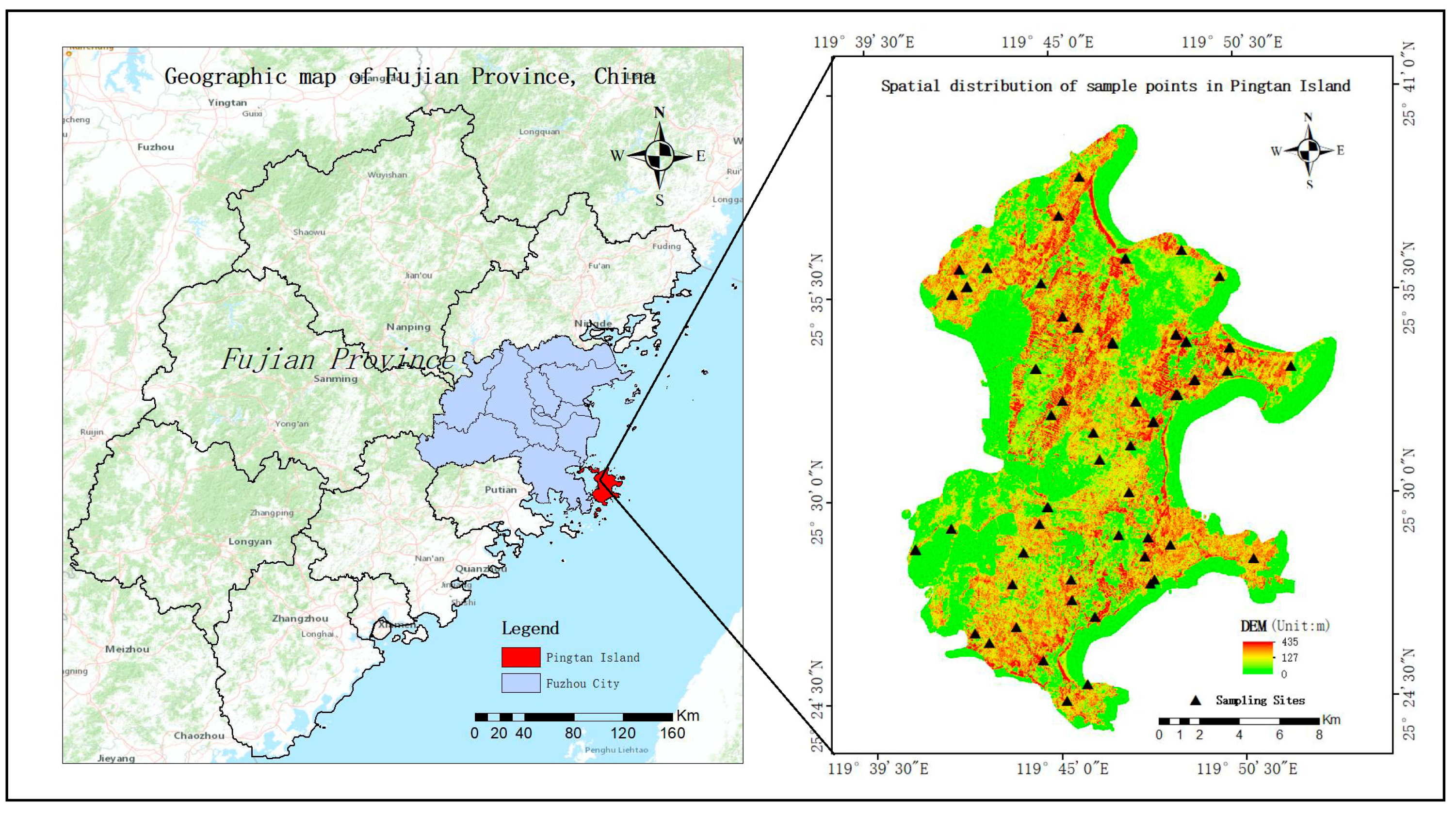
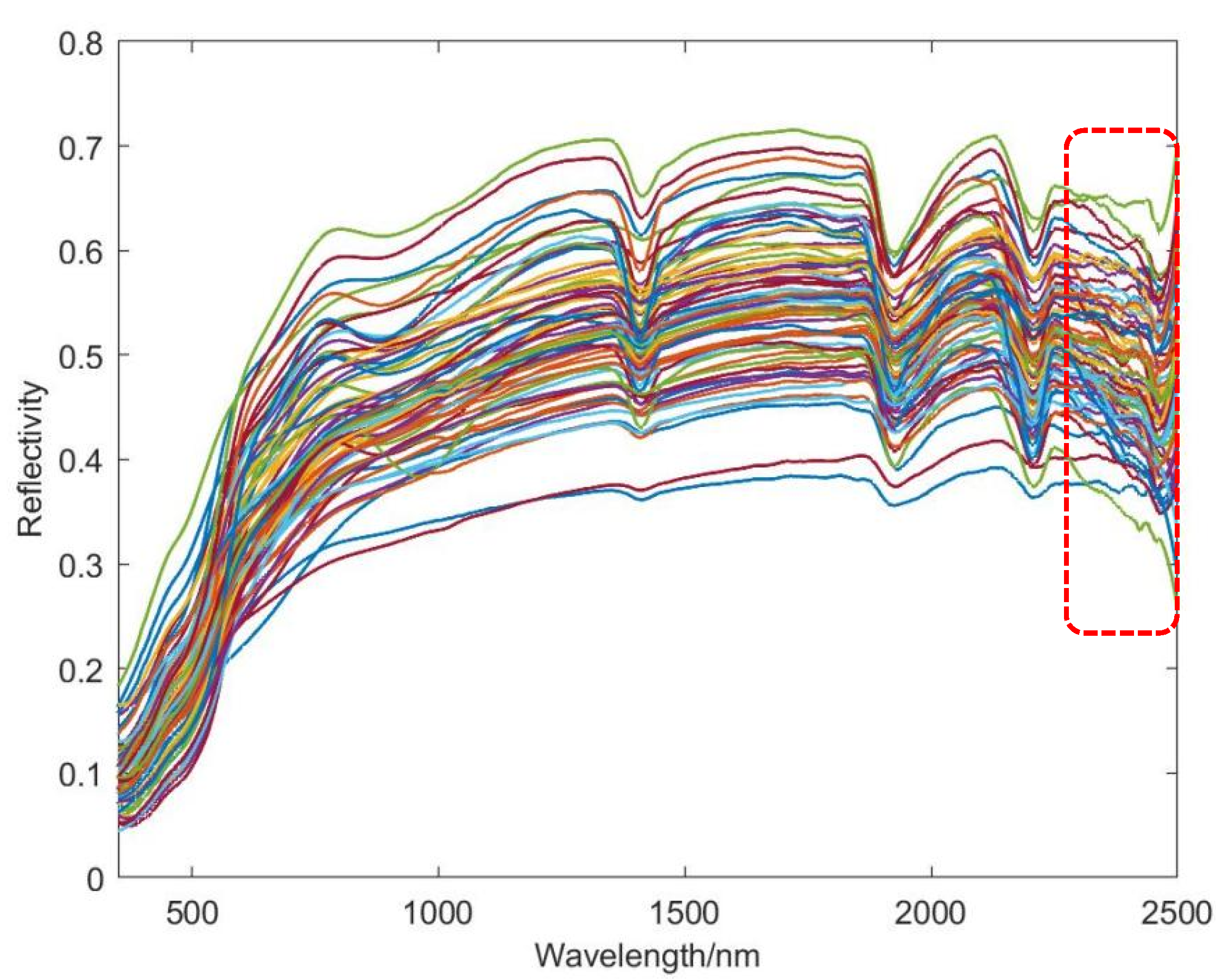

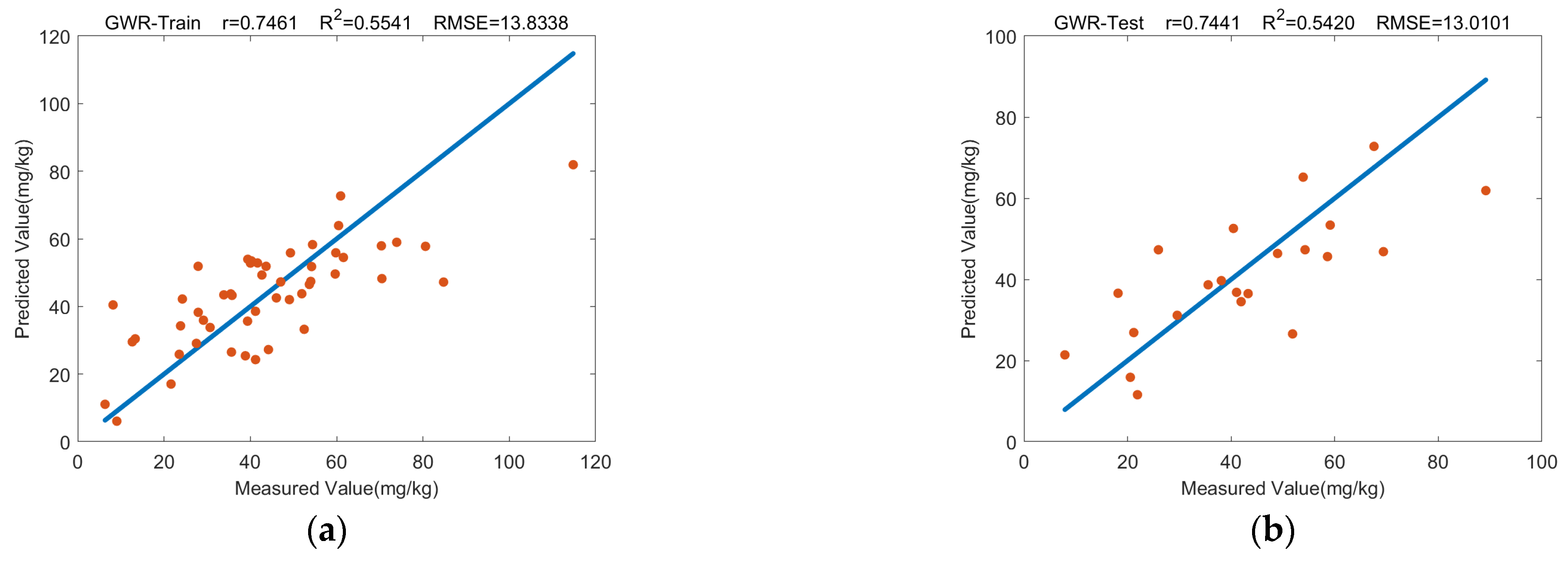
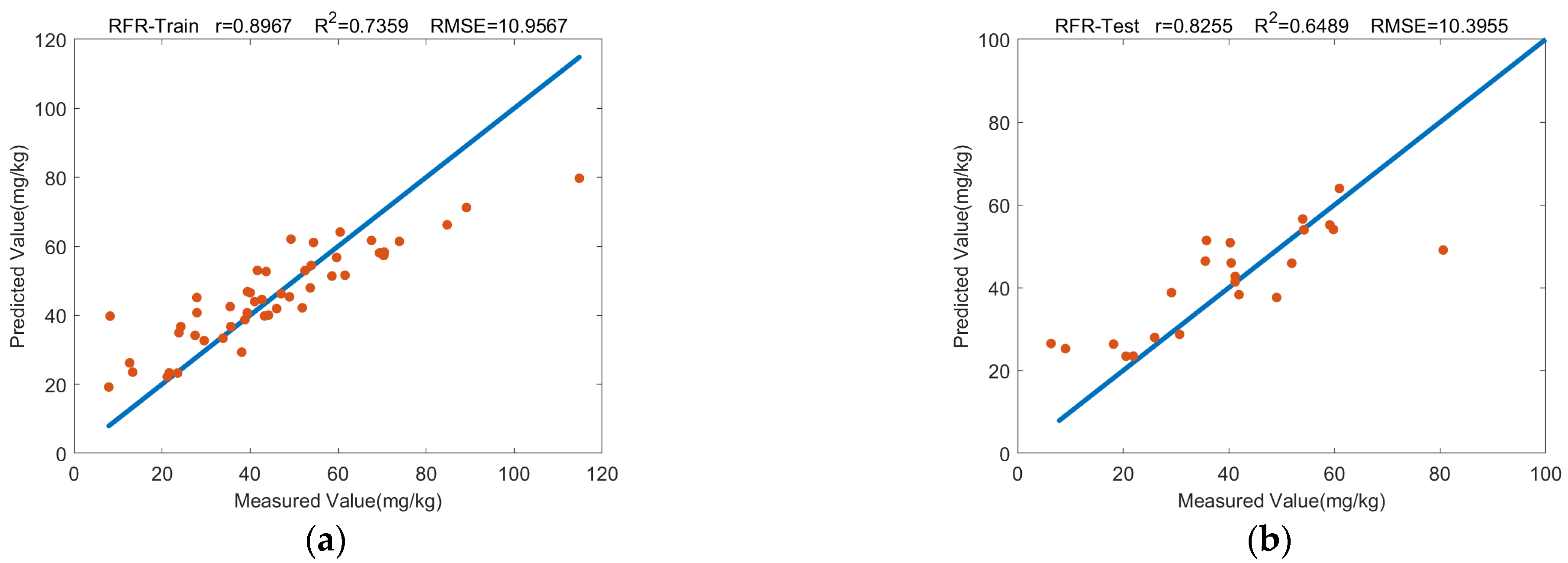
| Element | Standard Value in China (mg/kg) | Background Value in Fujian Province (mg/kg) | |||
|---|---|---|---|---|---|
| Type | PH <6.5 | PH 6.5–7.5 | PH >7.5 | ||
| As | dry land | 30 | 30 | 25 | 5.87 |
| paddy field | 40 | 25 | 20 | ||
| Element | Min | Max | Mean | SD | Skewness | Kurtosis | CV |
|---|---|---|---|---|---|---|---|
| As | 6.33 | 114.81 | 43.43 | 20.43 | 0.64 | 1.18 | 47 |
| Spectral Indicator | Original Characteristic Band /nm | Maximum Pearson’s Correlation Coefficient |
|---|---|---|
| SR | 2440 | 0.5264 ** |
| FD | 478 | 0.4460 ** |
| SD | 1398 | −0.4414 ** |
| RT | 2441 | −0.5151 ** |
| RTFD | 1349 | −0.4947 ** |
| RTSD | 1423 | 0.5145 ** |
| AT | 2440 | −0.5224 ** |
| ATFD | 1349 | −0.4622 ** |
| ATSD | 1423 | 0.4594 ** |
| CR | 2152 | 0.3882 ** |
| Spectral Indicator | Optimal Characteristic Band/nm | Second-Highest Correlation Coefficient |
|---|---|---|
| SR | 2212 | 0.4986 ** |
| RT | 2390 | −0.4954 ** |
| AT | 2384 | −0.4930 ** |
| Spectral Indicator | Optimal Characteristic Band/nm | High Correlation Coefficient |
|---|---|---|
| SR | 2212 | 0.4986 ** |
| RT | 2212 | −0.4839 ** |
| AT | 2212 | −0.4925 ** |
| Model | Training Data | Validation Data | ||||
|---|---|---|---|---|---|---|
| r | R2 | RMSE (mg/kg) | r | R2 | RMSE (mg/kg) | |
| MLR | 0.6400 ** | 0.4097 | 16.1806 | 0.6487 * | 0.4058 | 15.3761 |
| PLSR | 0.6720 ** | 0.4516 | 16.1028 | 0.6940 ** | 0.4738 | 11.8161 |
| GWR | 0.7461 ** | 0.5541 | 13.8338 | 0.7441 ** | 0.5420 | 13.0101 |
| BP | 0.7003 ** | 0.4895 | 15.1688 | 0.7358 ** | 0.5407 | 8.0496 |
| SVR | 0.6477 ** | 0.4163 | 15.5690 | 0.6389 * | 0.3899 | 15.6473 |
| RFR | 0.8967 ** | 0.7359 | 10.9567 | 0.8255 ** | 0.6489 | 10.3955 |
| Model | Training Data | Validation Data | ||||
|---|---|---|---|---|---|---|
| r | R2 | RMSE (mg/kg) | r | R2 | RMSE (mg/kg) | |
| MLR | 0.6500 ** | 0.4224 | 15.5881 | 0.7145 ** | 0.4287 | 15.7926 |
| PLSR | 0.66711 ** | 0.4504 | 14.8022 | 0.6842 ** | 0.4671 | 15.0733 |
| GWR | 0.7392 ** | 0.5407 | 12.9545 | 0.7982 ** | 0.6286 | 13.5795 |
| BP | 0.7186 ** | 0.4682 | 12.6433 | 0.6759 ** | 0.4426 | 12.7430 |
| SVR | 0.6597 ** | 0.4233 | 15.7397 | 0.6333 * | 0.3856 | 15.0533 |
| RFR | 0.8894 ** | 0.7347 | 10.9802 | 0.8004 ** | 0.6151 | 10.8847 |
| Model | Training Data | Validation Data | ||||
|---|---|---|---|---|---|---|
| r | R2 | RMSE (mg/kg) | r | R2 | RMSE (mg/kg) | |
| MLR | 0.6493 ** | 0.4215 | 16.2586 | 0.6954 ** | 0.4665 | 14.0281 |
| PLSR | 0.6777 ** | 0.4593 | 14.6014 | 0.7159 ** | 0.4912 | 15.0675 |
| GWR | 0.7301 ** | 0.5285 | 13.1248 | 0.8052 ** | 0.6461 | 13.2556 |
| BP | 0.6562 ** | 0.4105 | 14.9417 | 0.7331 ** | 0.5240 | 10.0690 |
| SVR | 0.6635 ** | 0.4352 | 15.7681 | 0.6165 * | 0.3640 | 14.8183 |
| RFR | 0.8996 ** | 0.7406 | 10.8576 | 0.7776 ** | 0.5878 | 11.2641 |
Disclaimer/Publisher’s Note: The statements, opinions and data contained in all publications are solely those of the individual author(s) and contributor(s) and not of MDPI and/or the editor(s). MDPI and/or the editor(s) disclaim responsibility for any injury to people or property resulting from any ideas, methods, instructions or products referred to in the content. |
© 2023 by the authors. Licensee MDPI, Basel, Switzerland. This article is an open access article distributed under the terms and conditions of the Creative Commons Attribution (CC BY) license (https://creativecommons.org/licenses/by/4.0/).
Share and Cite
Zheng, M.; Luan, H.; Liu, G.; Sha, J.; Duan, Z.; Wang, L. Ground-Based Hyperspectral Retrieval of Soil Arsenic Concentration in Pingtan Island, China. Remote Sens. 2023, 15, 4349. https://doi.org/10.3390/rs15174349
Zheng M, Luan H, Liu G, Sha J, Duan Z, Wang L. Ground-Based Hyperspectral Retrieval of Soil Arsenic Concentration in Pingtan Island, China. Remote Sensing. 2023; 15(17):4349. https://doi.org/10.3390/rs15174349
Chicago/Turabian StyleZheng, Meiduan, Haijun Luan, Guangsheng Liu, Jinming Sha, Zheng Duan, and Lanhui Wang. 2023. "Ground-Based Hyperspectral Retrieval of Soil Arsenic Concentration in Pingtan Island, China" Remote Sensing 15, no. 17: 4349. https://doi.org/10.3390/rs15174349
APA StyleZheng, M., Luan, H., Liu, G., Sha, J., Duan, Z., & Wang, L. (2023). Ground-Based Hyperspectral Retrieval of Soil Arsenic Concentration in Pingtan Island, China. Remote Sensing, 15(17), 4349. https://doi.org/10.3390/rs15174349








